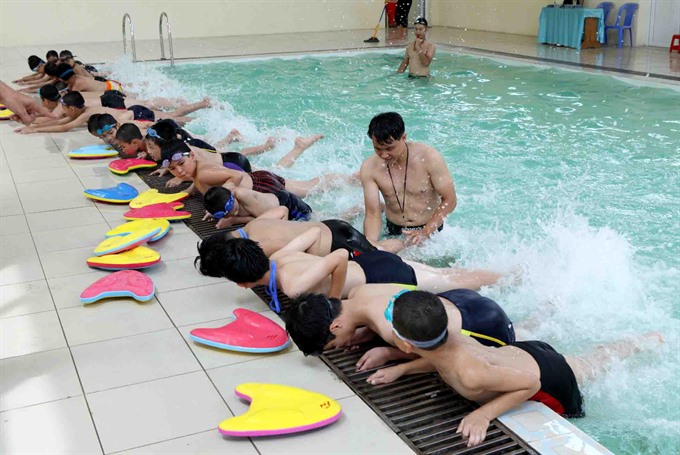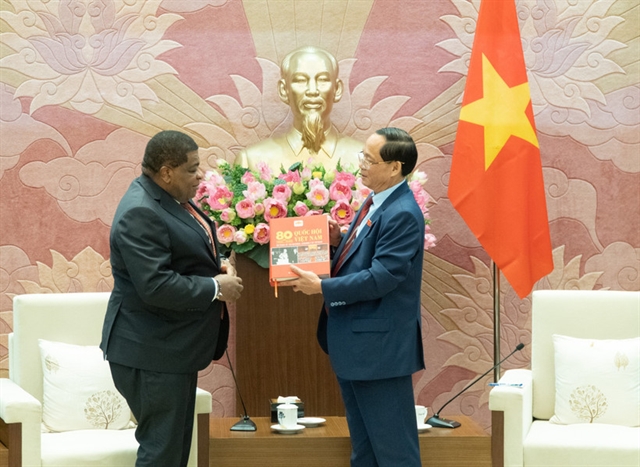 Society
Society

Physical education is considered as important as academic education, but the role of physical education is limited in many schools, showing the need for more investment in infrastructure and manpower in the field.
 |
| Students at Đông Mỹ Primary School in Hà Nội’s Thanh Trì District attend a swimming lesson. — VNA/VNS Photo Quý Trung |
HÀ NỘI — Physical education is considered as important as academic education, but the role of physical education is limited in many schools, showing the need for more investment in infrastructure and manpower in the field.
Incomplete statistics from the Ministry of Education and Training (MoET) showed that 95 per cent of schools nationwide had physical training in their curriculum, and 75 per cent of the schools organised sports as extracurricular activities. The activities attracted about 70 per cent of the 15 million students across the country.
But many schools lack infrastructure for physical training and sports extracurricular activities.
A joint circular from the MoET and the Ministry of Health, issued in 2011, regulated that areas for playing and physical training must occupy 40-50 per cent of a school’s total area.
But in fact, only about seven per cent of schools in the country have a sports hall, 15 per cent have sports grounds, and no more than one per cent have swimming pools.
In Hà Nội, while most state schools have playgrounds for students, many private schools do not have enough room for the activities as they have to rent space for classrooms. About one third of private schools have playgrounds.
On the other side of the coin, research from Hà Nội Mới (New Hà Nội) newspaper showed that in some Hà Nội districts, local authorities pay much attention to physical education.
Thanh Trì District spent large amount of funds to build swimming pools for students in 15 out of 16 communes, while Thanh Xuân District set up mobile swimming pools for students and the Sài Đồng Residential Zone’s Primary School in Long Biên District teaches its students swimming at the district’s sports centre every Monday.
More and more children have taken up Taekwondo recently, and it is taught in some schools in Tây Hồ and Nam Từ Liêm districts. Some schools in Cầu Giấy, Hai Bà Trưng and Ba Đình districts hold basketball training for students.
Important duty
In a conference with the MoET at the end of last month, Deputy Prime Minister Vũ Đức Đam said that physical education must be equal with academics, and teaching and studying methods must be changed to keep it interesting.
Assessing the quality of physical training and sports training must be based on students’ capacity and enjoyment, and investment must be suitable to reality, said the Deputy PM.
Academic education and physical education are the two most important duties of the education and training sector, which was shown in Resolution 29-NQ/TW and Decision 1076/QĐ-TTg issued last year.
Experts from the MoET said that under the project developing physical training and sports in schools in 2016-20 with a vision to 2025, students could select one sport to play from grade 1. Two periods a week should be spent on physical education.
To have better training quality, students are divided into groups based on their physical condition, with the weak divided from the strong.
Cảnh Bạch Yến, principal of the Việt Nam-Algeria Junior Secondary School in Thanh Xuân District said that besides two periods of physical training per week, the school ran sports clubs for students.
The school planned to build a football ground and a basketball court for the students with funds contributed by the school’s teachers, she said.
To resolve the shortage of manpower for physical training at schools, the MoET will check physical training teachers at schools, and then give guidance to schools and sports training schools.
The project on developing manpower for the education sector from now until 2020 said that each year, the sector needed 460 teachers for physical training, and most of them should work in primary schools. — VNS




